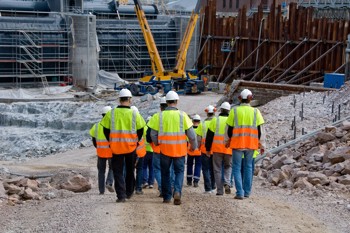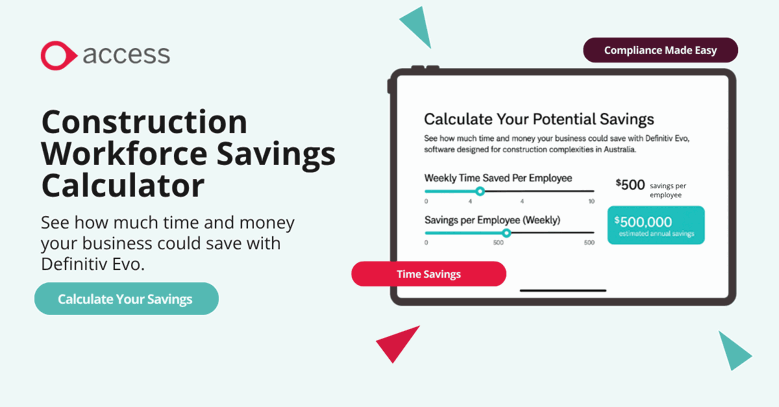
Introduction
Employee scheduling in construction is more than rostering shifts. It’s ensuring the right people, with the right skills, are in the right place at the right time. Done well, it keeps projects running smoothly. Done poorly, it leads to delays, compliance issues, and payroll errors.
Yet many businesses still rely on manual spreadsheets, WhatsApp messages, and phone tag to manage this complexity. Site supervisors burn hours updating rosters. Teams juggle multiple schedule versions. Workers arrive at the wrong site because they missed a text. This approach simply cannot keep pace with today's construction workforce, especially when crews, subcontractors, and equipment are constantly moving across multiple sites.
What is an employee schedule in construction?
An employee schedule shows exactly who works where, when, and on what tasks. But here's what separates good from great: capturing the complete picture.
Beyond shift times, an effective employee schedule tracks:
-
Worker certifications and site inductions
-
Equipment qualifications and ticket expiry dates
-
Travel time between sites
-
Fatigue management requirements
-
EBA conditions and allowances
This is different from a job schedule which focuses on “what” tasks and timelines, while an employee schedule manages the “who”. Both are essential, and work best when they are aligned.
|
Job Schedule |
Employee Schedule |
|
Focus: Tasks and timelines |
Focus: People and skills |
|
Tracks: What needs to be done |
Tracks: Who will do it |
|
Manages: Project milestones and deadlines |
Manages: Worker allocation and availability |
|
Ensures: Work happens in the right sequence |
Ensures: Qualified workers are in the right place |
|
Example: Concrete pour scheduled Tuesday |
Example: 4 certified concreters rostered Tuesday 7am-3pm |
When properly aligned, these schedules work seamlessly. Project managers confidently commit to deadlines. Payroll processes hours without disputes. Site supervisors know exactly who's showing up. Workflows smoothly from one stage to the next.
Why effective employee scheduling matters
By nature, construction projects move and change quickly. Without effective scheduling, small mistakes can quickly escalate into bigger issues.
Let's examine what poor scheduling costs businesses:
The direct costs: A missing crane operator delays a floor pour — that's $15,000 in standby charges. An incorrectly scheduled night shift triggers unbudgeted penalty rates. A compliance breach from excessive hours leads to safety incidents and investigations.
The indirect costs:
🔄 Constant firefighting prevents managers from winning new work
😤 Worker frustration from schedule chaos increases turnover
📉 Reputation damage when delays become standard
💸 Cash flow pressure from delayed progress claims
In contrast, when scheduling is done effectively:
✅ Reduced delays - Aligning workforce availability with project timelines eliminates expensive standdowns and keeps projects moving.
✅ Less admin burden - Automated tools replace spreadsheets, slashing hours spent on phone calls, roster updates, and data entry.
✅ Higher productivity — Better resource utilisation ensures the right skills are deployed at the right time, improving on-site visibility and reducing rework.
Core principles of employee scheduling
Effective scheduling isn't about having the latest software — it's about getting the fundamentals right. Here are the core principles to take note of:
1. Workforce planning basics
Before creating any schedule, businesses need a clear picture of their workforce capabilities. This means mapping:
-
Current certifications and license expiry dates
-
Site inductions and safety clearances
-
Skills levels and equipment qualifications
-
Availability patterns and location constraints
-
EBA conditions and individual allowances
Without this foundation, even the best tools become expensive guesswork. One expired white card or missed induction can shut down an entire site.
2. Match scheduling method to project needs
Different projects demand different approaches:
Gantt charts work well for straightforward projects, providing visual clarity on labour allocation across timelines. Teams can quickly spot resource conflicts and adjust before problems arise.
Critical Path Method becomes essential for complex builds, ensuring skilled workers focus on tasks that directly impact completion dates. When every day counts, this method prevents bottlenecks by aligning labour with critical milestones.
3. Master the key concepts
The difference between good and great scheduling lies in the consistent application of these key concepts:
-
Shift planning that respects fatigue limits while maintaining coverage
-
Overtime control that prevents budget blowouts from penalty rates
-
Resource levelling that smooths peaks and troughs in labour demand
-
Risk mitigation through buffer time for weather, permits, and the unexpected
These aren't just nice-to-haves, they're the daily practices that keep projects profitable and workers safe.
Modern tools & techniques
Spreadsheets may be the familiar choice, but they create blind spots, errors and struggle to keep up with today’s workforce demands. Workforce management software provides a better way to schedule and communicate from start to finish.
Here's what modern scheduling looks like:
🔔 Real time updates so schedules adapt as projects change. Rain delays tomorrow's pour? Everyone knows within seconds.
📱Mobile access for crews and supervisors in the field.
📍Live tracking shows exactly where crews are. No guessing, no gaps.
✅ Centralised data that connects rostering, payroll, and compliance.
💰 Analytics that surface labour cost trends and productivity.
Must-have features in a software for construction
Construction complexities are unique, therefore require a solution that is built to address them. Explore our all-in-one solution, purpose-built solution for construction workforce in Australia.
Key features to look for include:
✅ Skills-based matching — Automatically suggests qualified workers based on certifications and experience for each task
✅ Conflict detection — Prevents double-booking and alerts when workers are scheduled across multiple sites
✅ Mobile-first design — Works reliably on muddy sites with poor reception, not just office desks
✅ Compliance monitoring — Flags fatigue risks, overtime breaches, and expiring certifications before they become problems
✅ Cost tracking — Shows real-time labour costs versus budget, helping identify overruns before they spiral
💡 Pro tip: Look for systems that integrate workforce management and payroll in one platform. Access Definitiv does exactly this — schedule changes update payroll automatically, timesheets flow straight through for processing, and compliance is built in.
The result? Seamless workforce management from schedule to payment, with the visibility and control construction businesses need.
Ready to see your potential savings?
Use our saving calculator to uncover how much time, budget, and strategic capacity you could unlock with Access Definitiv Evo.
Best practices for employee scheduling
Choose intuitive, mobile-friendly tools for field teams
If it doesn't work on phones at muddy sites, it doesn't work in construction. Choose intuitive systems that field teams can actually use, not office-only solutions.
Connect your systems
Integrate scheduling with payroll and project management systems. When data flows between platforms automatically, double-handling disappears and accuracy improves.
Invest in your people
Provide proper training and actively gather feedback. When teams see their input leads to real improvements, they become less resistant of change and more likely to become advocates.
Step-by-step workflow
A clear process makes scheduling easier to manage and easier to improve.
- Centralise schedules in one digital platform
A single source of truth reduces version control issues and prevents conflicting rosters.
- Assign workers by skills and availability
Match certifications and experience to task needs. Include travel time, fatigue rules, and site access constraints. - Communicate updates instantly
Use mobile alerts for changes and confirmations. Make it easy for employees to acknowledge shifts and raise conflicts. - Track hours and compliance in real time
Capture attendance, breaks, and allowances accurately. Apply rules automatically so payroll does not need to fix errors later.
- Analyse performance and refine
Review overtime drivers, no show patterns, and site bottlenecks. Use these insights to adjust rosters and improve the next plan.
A well-planned workflow brings consistency across sites and improves accountability. It also builds confidence in the process because people see that schedules are fair, accurate, and responsive.
Common challenges and solutions
Problem: “We keep getting double-bookings and no-shows"
Solution: Conflict detection and automated alerts catch problems before they happen. Workers get confirmations, managers see conflicts — no more empty sites or overcrowded crews.
Problem: "Last-minute changes throw everything off"
Solution: Mobile-first tools let you adjust instantly. When plans change, update once and everyone's notified. What used to take hours of phone calls now takes seconds.
Problem: “The crew won't use new technology"
Solution: Start with simple apps and proper training. When workers see it's just one-button clock-in and they're paid accurately every time, resistance fades quickly.
Conclusion
For construction businesses ready to take control, the path is clear: better scheduling means better margins, stronger compliance, and the confidence to take on bigger projects. By moving to digital solutions, businesses gain real time visibility, stronger compliance, and greater control of labour costs.
The shift to digital doesn't have to happen overnight. Plan it out to keep adoption smooth while reaping the benefits both on site and in the office:
✅ Start with a pilot project, train your champions.
✅ Scale as success builds momentum.
What if scheduling was no longer a daily struggle?
Complexity may be the norm, but with Definitiv Evo – it’s a standard practice. Built for the industry's complexity, our solution gives leaders clarity to manage labour costs, compliance, and workforce planning. Watch the demo to see in action.
👉 Discover your potential savings
Use our calculator to see how much time, budget, and strategic capacity you could unlock with Definitiv Evo.
📥 Want the latest insights and proven strategies?
Download our Workforce Management Guide for the Construction Industry

 UK
UK
 SG
SG
 MY
MY
 US
US
 IE
IE
